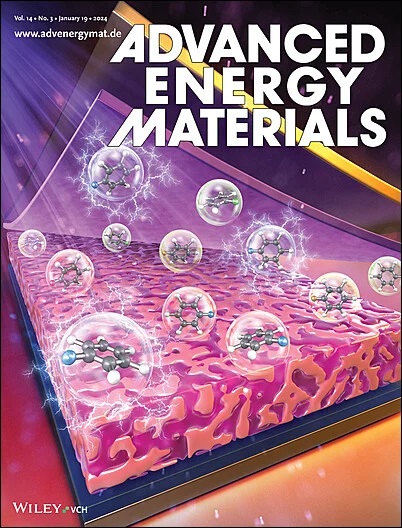用小分子桥界面钝化法制备稳定钙钛矿
IF 24.4
1区 材料科学
Q1 CHEMISTRY, PHYSICAL
引用次数: 0
摘要
钙钛矿太阳能电池(PSCs)中各层的界面对电荷转移和复合有重要影响。特别是,p-i-n型PSCs中钙钛矿与空穴传输层(HTL)之间的界面严重影响了HTL与钙钛矿之间的接触特性,阻碍了性能和稳定性的进一步提高。本文引入了一个小分子9-氟酰甲氧羰基氯(9-YT)作为p-i-n PSCs的分子桥,增强了自组装分子(sam)与钙钛矿之间的相互作用。9-YT的共轭主链可与SAM分子(MeO-2PACz)通过π -π堆积反应相互作用。此外,9-YT还通过与钙钛矿的强相互作用改善了界面接触,其中9-YT中的羰基和Cl原子与钙钛矿层中的不配位Pb2+相互作用。分子桥的加入显著增强了钙钛矿/空穴传输层界面上的空穴萃取,优化了能级排列,减轻了界面电荷复合,钝化了钙钛矿中不配合的Pb2+和缺陷。最后,经过9-YT处理的器件功率转换效率(PCE)达到24.82%。同时,经过1200 h的长期稳定性测试,PSCs仍能保持原始PCE的92.6%。本文章由计算机程序翻译,如有差异,请以英文原文为准。

Constructing Stable Perovskite with Small Molecule Bridge Interface Passivation
The interfaces of each layer in perovskite solar cells (PSCs) have a significant impact on the charge transfer and recombination. Especially, the interface between perovskite and the hole transport layer (HTL) in p-i-n type PSCs significantly affects the contact characteristics between the HTL and perovskite, hindering further improvements in performance and stability. Herein, a small molecule 9-Fluorenylmethoxycarbonyl chloride (9-YT) is introduced as a molecule bridge for p-i-n PSCs, which enhances the interaction between self-assembly molecules (SAMs) and perovskite. The conjugated backbone of 9-YT can interact with the SAM molecule (MeO-2PACz) by π–π stacking reaction. Moreover, 9-YT also improves the interfacial contact through strong interactions with the perovskite, where the carbonyl groups and Cl atoms in 9-YT interact with uncoordinated Pb2+ in perovskite layer. The incorporation of a molecule bridge is demonstrated to markedly enhance hole extraction at the perovskite/hole transport layer interface, optimize energy level alignment, mitigate interface charge recombination, and passivate the uncoordinated Pb2+ and defects in the perovskite. Finally, the device treated with 9-YT achieves a power conversion efficiency (PCE) of 24.82%. At the same time, PSCs can still maintain 92.6% of the original PCE after a long-term stability test of 1200 h.
求助全文
通过发布文献求助,成功后即可免费获取论文全文。
去求助
来源期刊

Advanced Energy Materials
CHEMISTRY, PHYSICAL-ENERGY & FUELS
CiteScore
41.90
自引率
4.00%
发文量
889
审稿时长
1.4 months
期刊介绍:
Established in 2011, Advanced Energy Materials is an international, interdisciplinary, English-language journal that focuses on materials used in energy harvesting, conversion, and storage. It is regarded as a top-quality journal alongside Advanced Materials, Advanced Functional Materials, and Small.
With a 2022 Impact Factor of 27.8, Advanced Energy Materials is considered a prime source for the best energy-related research. The journal covers a wide range of topics in energy-related research, including organic and inorganic photovoltaics, batteries and supercapacitors, fuel cells, hydrogen generation and storage, thermoelectrics, water splitting and photocatalysis, solar fuels and thermosolar power, magnetocalorics, and piezoelectronics.
The readership of Advanced Energy Materials includes materials scientists, chemists, physicists, and engineers in both academia and industry. The journal is indexed in various databases and collections, such as Advanced Technologies & Aerospace Database, FIZ Karlsruhe, INSPEC (IET), Science Citation Index Expanded, Technology Collection, and Web of Science, among others.
 求助内容:
求助内容: 应助结果提醒方式:
应助结果提醒方式:


